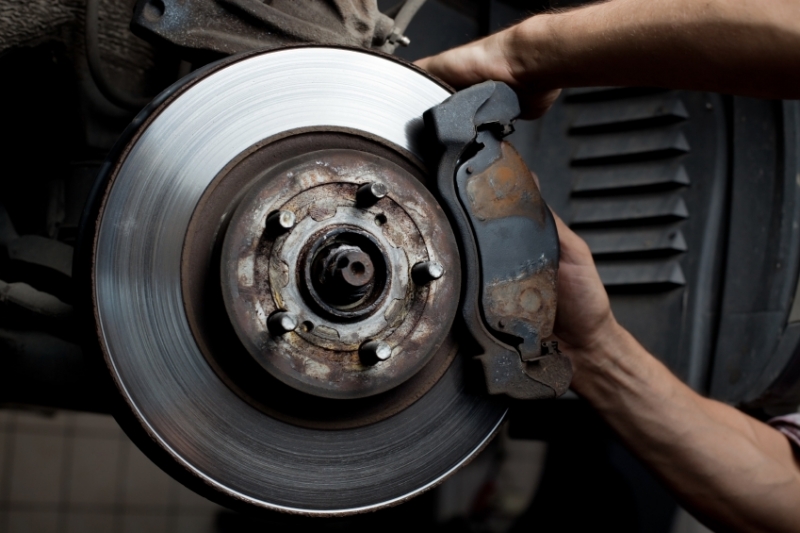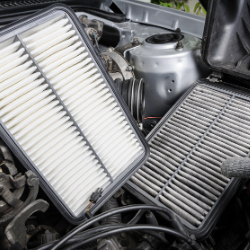Car Brakes: How Do You Know When to Change Them?
Vehicle brakes are vital to your safety when driving. What signs indicate that they're wearing out?
By Zach Bowman
For those who suffer a daily commute through heavy traffic, your vehicle's braking system can bring thousands of pounds of metal, plastic and empty Starbucks cups to a stop hundreds of times before you get to work. It goes without saying that these pieces wear out, but they do so slowly, meaning you may not notice they need attention until it's too late.
Neglecting your braking system can lead to increased repair costs, or worse, no brakes at all. Fortunately, paying attention to some of the signs of brake wear can keep you on top of stopping maintenance, saving you some money and keeping your car from bouncing off of the guy in front of you.
The most obvious indicator that your vehicle's brakes need attention is an incredibly high pitched squeal when you come to a stop. Brake pad manufacturers include a little piece of metal called an indicator on the pad itself. When the material wears down to the point where less than ¼ inch is left, the metal piece begins to touch the vehicle's rotor, doing a pretty good impression of fingernails on a chalkboard. Depending on how hard you drive, that usually means you should replace your brake pads within the month.
Occasionally, the indicator rusts and falls off, leaving you with no irritating noise to warn of brake wear. Additionally, many aftermarket and low-cost pads don’t come with a wear indicator at all. For the more observant, there are other signs that your pads need attention. If it takes you longer to stop than it used to, or if your brake pedal travels farther than it did a few months ago, it might be a good idea to get your stoppers checked. Regular pad checks are a good idea and require little more than removing a wheel and knowing what to look for.
Rotors are a little trickier, as they can usually last through two or three sets of brake pads before needing to be replaced. If your steering wheel wiggles in your hands when you come to a stop, your rotors are probably "warped," and it's a good idea to swap them out.


Your mechanic might offer to "turn" your rotors for you instead of outright replacing them, if it's an option. This means shaving enough metal off of the rotors to make them smooth again. Newer vehicles are equipped with thinner, lighter rotors to save on costs and increase fuel economy. If you've got the option, go ahead and replace them.


There are several options for replacement brake parts for your vehicle. While you can never go wrong with what your manufacturer recommends, a variety of aftermarket parts can help you cater your brake system to your driving style. If you find yourself replacing rotors often, you might consider switching to a slotted version. While initially more expensive, the slots disperse heat better than stock, though 99 percent of the time they aren’t necessary for the average driver.
Your rotors aren't the only piece of brake hardware that can be changed for better performance. One of the most common brake pad upgrades is a switch to ceramic pads. These pads stop just as well, if not better than the stock pieces, but produce much less dust and are generally quieter. While you can also install performance brake pads on your vehicle, these usually have a shorter life span and generate more wear on your rotors.
While neglecting your brakes until your car is grinding to a halt instead of gliding is always an option, it can cost you in unnecessary rotor replacement and possible towing bills. That's not to mention the likelihood of losing most of your stopping ability right when you need it most. Keeping up with brake maintenance, paying attention to the signs of brake wear and choosing the right equipment for your vehicle will let you slow down like you should.
|
|
Track Your Service Records
Get Recall Alerts
Get Updated Value Estimates on Your Car.
Go to a Review
Similar Articles
Popular Car Articles
Latest Car Reviews
Auto Tools
Local Guides
All Guides
Alabama
Alaska
Arizona
Arkansas
California
Colorado
Connecticut
DC
Delaware
Florida
Georgia
Hawaii
Idaho
Illinois
Indiana
Iowa
Kansas
Kentucky
Louisiana
Maine
Maryland
Massachusetts
Michigan
Minnesota
Mississippi
Missouri
Montana
Nebraska
Nevada
New Hampshire
New Jersey
New Mexico
New York
North Carolina
North Dakota
Ohio
Oklahoma
Oregon
Pennsylvania
Rhode Island
South Carolina
South Dakota
Tennessee
Texas
Utah
Vermont
Virginia
Washington
West Virginia
Wisconsin
Wyoming
Alabama
Alaska
Arizona
Arkansas
California
Colorado
Connecticut
DC
Delaware
Florida
Georgia
Hawaii
Idaho
Illinois
Indiana
Iowa
Kansas
Kentucky
Louisiana
Maine
Maryland
Massachusetts
Michigan
Minnesota
Mississippi
Missouri
Montana
Nebraska
Nevada
New Hampshire
New Jersey
New Mexico
New York
North Carolina
North Dakota
Ohio
Oklahoma
Oregon
Pennsylvania
Rhode Island
South Carolina
South Dakota
Tennessee
Texas
Utah
Vermont
Virginia
Washington
West Virginia
Wisconsin
Wyoming











